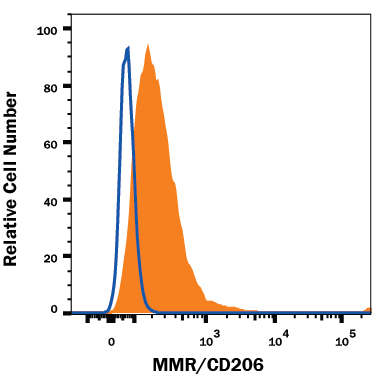Mouse MMR/CD206 APC-conjugated Antibody Summary
Leu19-Ala1388
Accession # Q61830
Applications
Please Note: Optimal dilutions should be determined by each laboratory for each application. General Protocols are available in the Technical Information section on our website.
Scientific Data
 View Larger
View Larger
Detection of MMR/CD206 in J774A.1 Mouse Cell Line by Flow Cytometry. J774A.1 mouse reticulum cell sarcoma macrophage cell line was stained with Rat Anti-Mouse MMR/CD206 APC-conjugated Monoclonal Antibody (Catalog # FAB25351A, filled histogram) or isotype control antibody (Catalog # IC005A, open histogram). View our protocol for Staining Membrane-associated Proteins.
Reconstitution Calculator
Preparation and Storage
- 12 months from date of receipt, 2 to 8 °C as supplied.
Background: MMR/CD206
The MMR (macrophage mannose receptor) is also called MR due to its presence on cells other than macrophages, and is designated CD206, Mrc1 (mannose receptor C type 1), or CLEC13D (C‑type lectin domain family 13, member D) (1‑4). CD206 is a 175 kDa endocytic receptor that is expressed on M2 alternatively activated tissue macrophages including tumor‑associated macrophages (TAMs), inflammatory dendritic cells in selected lymphoid organs, and liver, splenic, lymphatic, and dermal microvascular endothelial cells (1, 2, 5‑8). The 1456 amino acid (aa) mouse CD206 precursor contains a signal sequence (19 aa), an extracellular domain (ECD) containing an N‑terminal cysteine‑rich domain, a fibronectin type II repeat, eight C‑type lectin domains (CTLDs), and several N‑glycosylation sites (1369 aa), a transmembrane segment and a short (47 aa) cytoplasmic domain (2‑4). Metalloproteinases can mediate the shedding of the soluble ECD (2). The mouse CD206 ECD shares 96% aa sequence identity with rat MR, and 83‑84% with human, equine, porcine and canine CD206. The cysteine-rich domain recognizes some pituitary hormones such as LH (luteinizing hormone/lutropin) and TSH (thyroid stimulating hormone/thyrotropin), chondroitin sulfates, and sulfated N‑acetylgalactosamines including sulfo‑Lewisa and ‑Lewisx (1, 7, 9). The FNII domain mediates Ca2+‑independent binding of collagens (2, 10). The CTLDs participate in Ca2+‑dependent recognition of branched sugars with terminal mannose, fucose or N‑acetylglucosamine that occur on many pathogenic microorganisms (7, 11). CD206 internalizes ligands in clathrin-coated vesicles, sorts them to phagosomes or early endosomes, and recycles to the cell surface (1, 6, 7). CD206 also promotes clearance of glycoproteins that promote allergy or ongoing inflammation, such as lysosomal hydrolases and myeloperoxidases (1, 2, 5‑7). It is involved in T cell polarization and production of pro‑ and anti‑inflammatory cytokines (1, 2). It facilitates peptide presentation on MHC II, and cross‑presentation on MHC I which is important for tumor immunogenicity (1, 2, 12). This function may be blocked by engagement of CD206 on TAMs by tumor mucins (8).
- Gazi, U. and L. Martinez-Pomares (2009) Immunobiology 214:554.
- Martinez-Pomares, L. (2012) J. Leukoc. Biol. 92:1177.
- Harris, N. et al. (1992) Blood 80:2363.
- Taylor, M.E. et al. (1990) J. Biol. Chem. 265:12156.
- Chieppa, M. et al. (2003) J. Immunol. 171:4552.
- Figdor, C. et al. (2002) Nat. Rev. Immunol. 2:77.
- Taylor, P.R. et al. (2005) Trends Immunol. 26:104.
- Allavena, P. et al. (2010) Clin. Dev. Immunol. 2010:547179.
- Leteux, C. et al. (2000) J. Exp. Med. 191:1117.
- Martinez-Pomares, L. et al. (2006) Eur. J. Immunol. 36:1074.
- Taylor, M.E. et al. (1992) J. Biol. Chem. 267:1719.
- Singh S.K. et al. (2011) Eur. J. Immunol. 41:916.
Product Datasheets
Citation for Mouse MMR/CD206 APC-conjugated Antibody
R&D Systems personnel manually curate a database that contains references using R&D Systems products. The data collected includes not only links to publications in PubMed, but also provides information about sample types, species, and experimental conditions.
1 Citation: Showing 1 - 1
-
Histone deacetylase 9 deficiency exaggerates uterine M2 macrophage polarization
Authors: Y Liu, M Du, HY Lin
Journal of Cellular and Molecular Medicine, 2021-06-19;0(0):.
Species: Mouse
Sample Types: Whole Cells
Applications: Flow Cytometry
FAQs
No product specific FAQs exist for this product, however you may
View all Antibody FAQsReviews for Mouse MMR/CD206 APC-conjugated Antibody
There are currently no reviews for this product. Be the first to review Mouse MMR/CD206 APC-conjugated Antibody and earn rewards!
Have you used Mouse MMR/CD206 APC-conjugated Antibody?
Submit a review and receive an Amazon gift card.
$25/€18/£15/$25CAN/¥75 Yuan/¥2500 Yen for a review with an image
$10/€7/£6/$10 CAD/¥70 Yuan/¥1110 Yen for a review without an image

